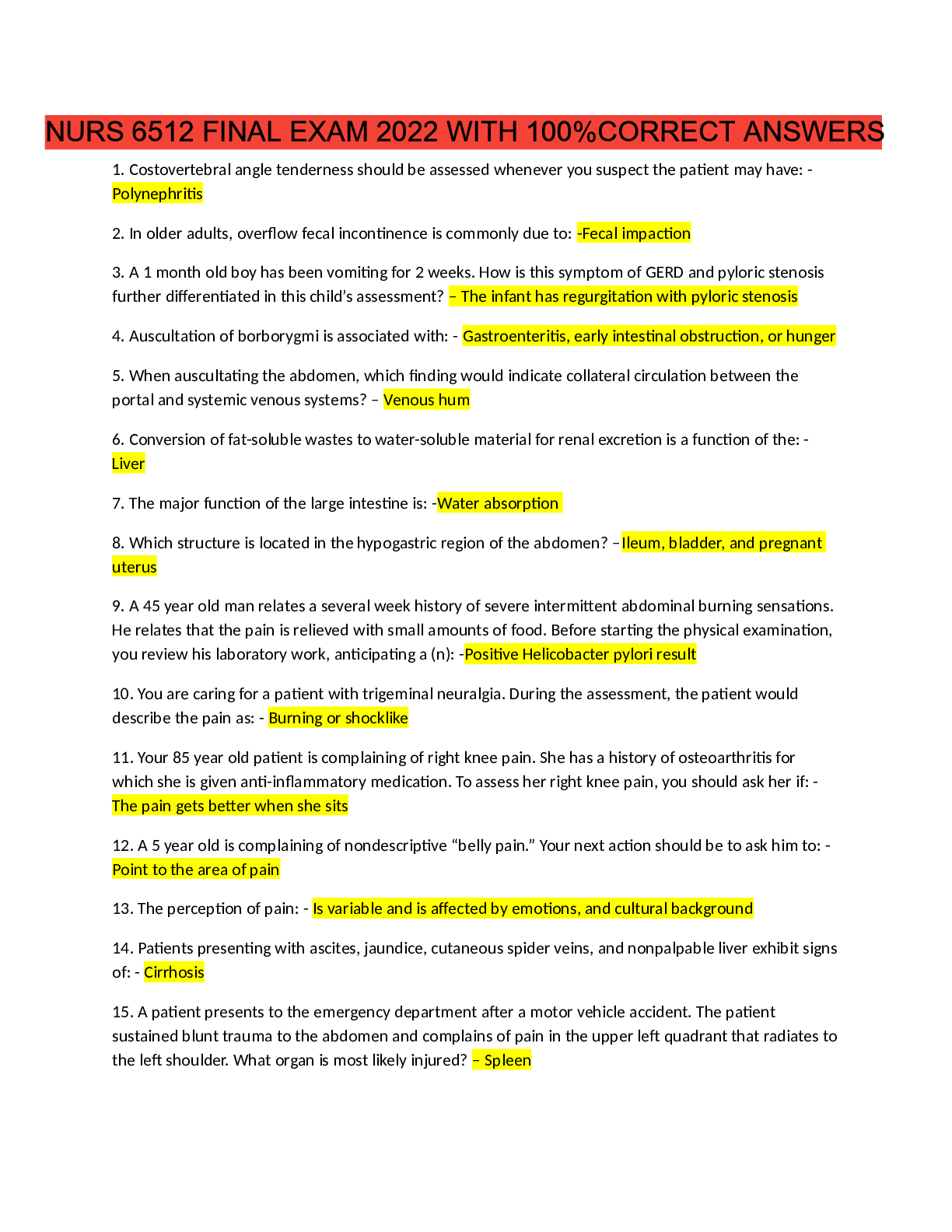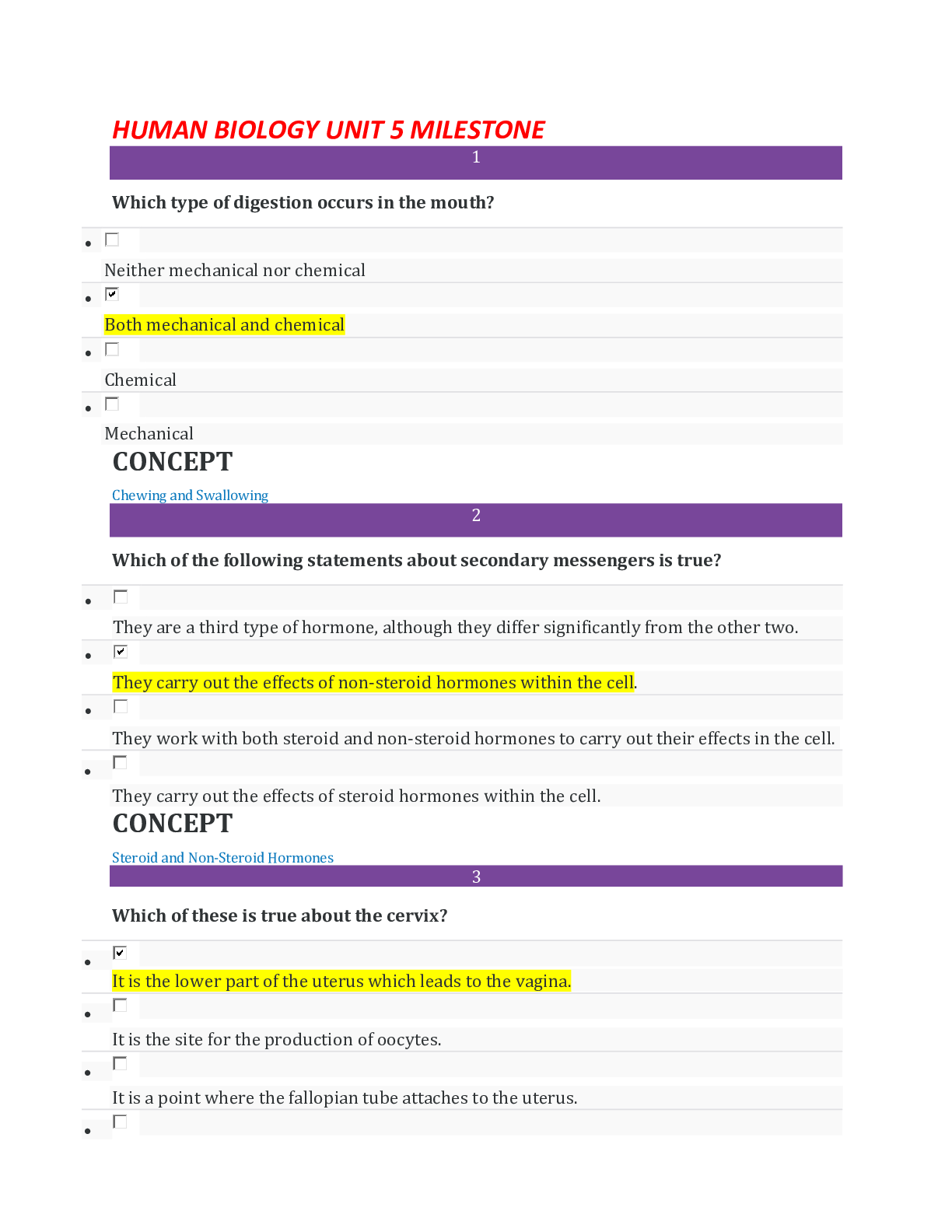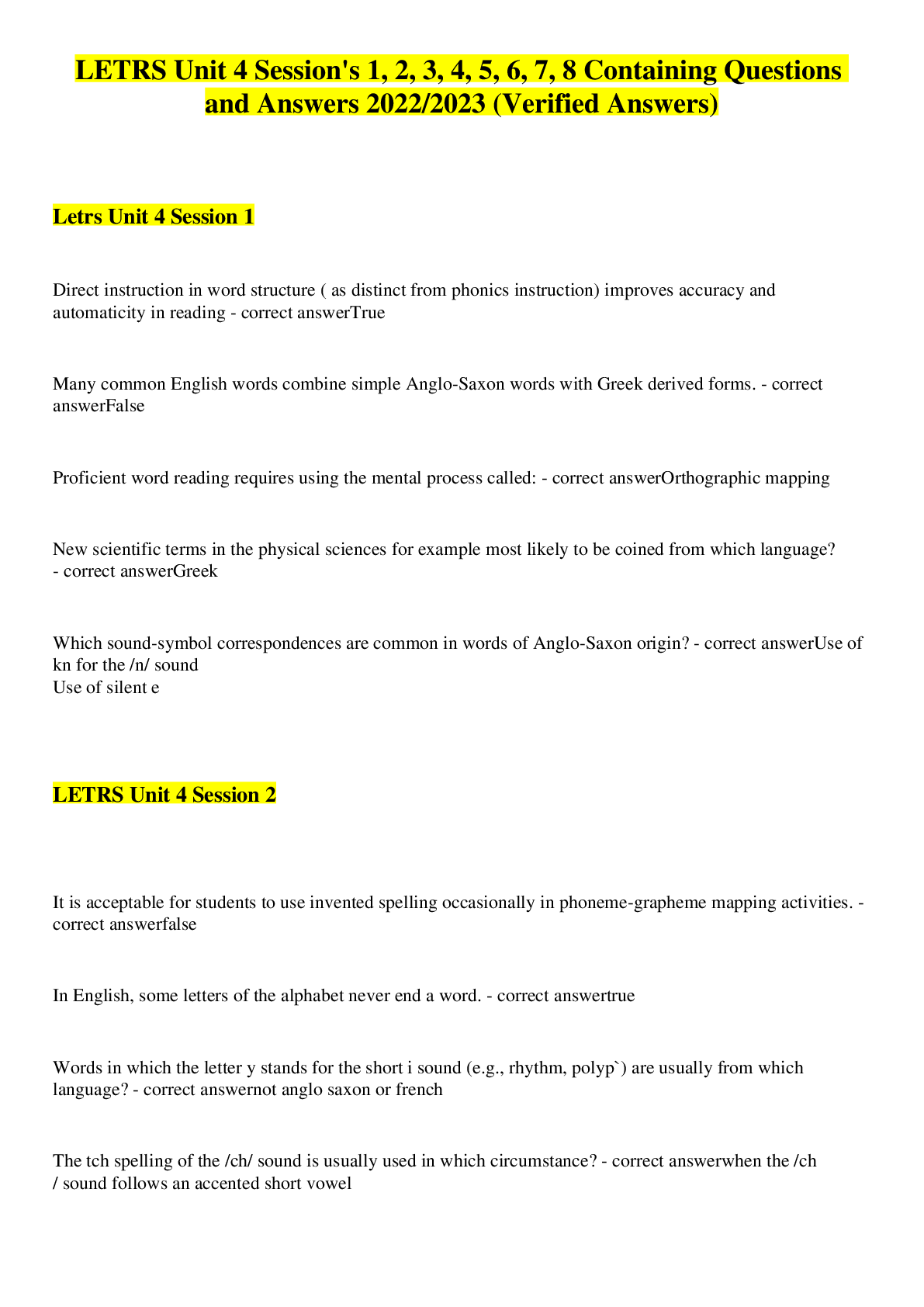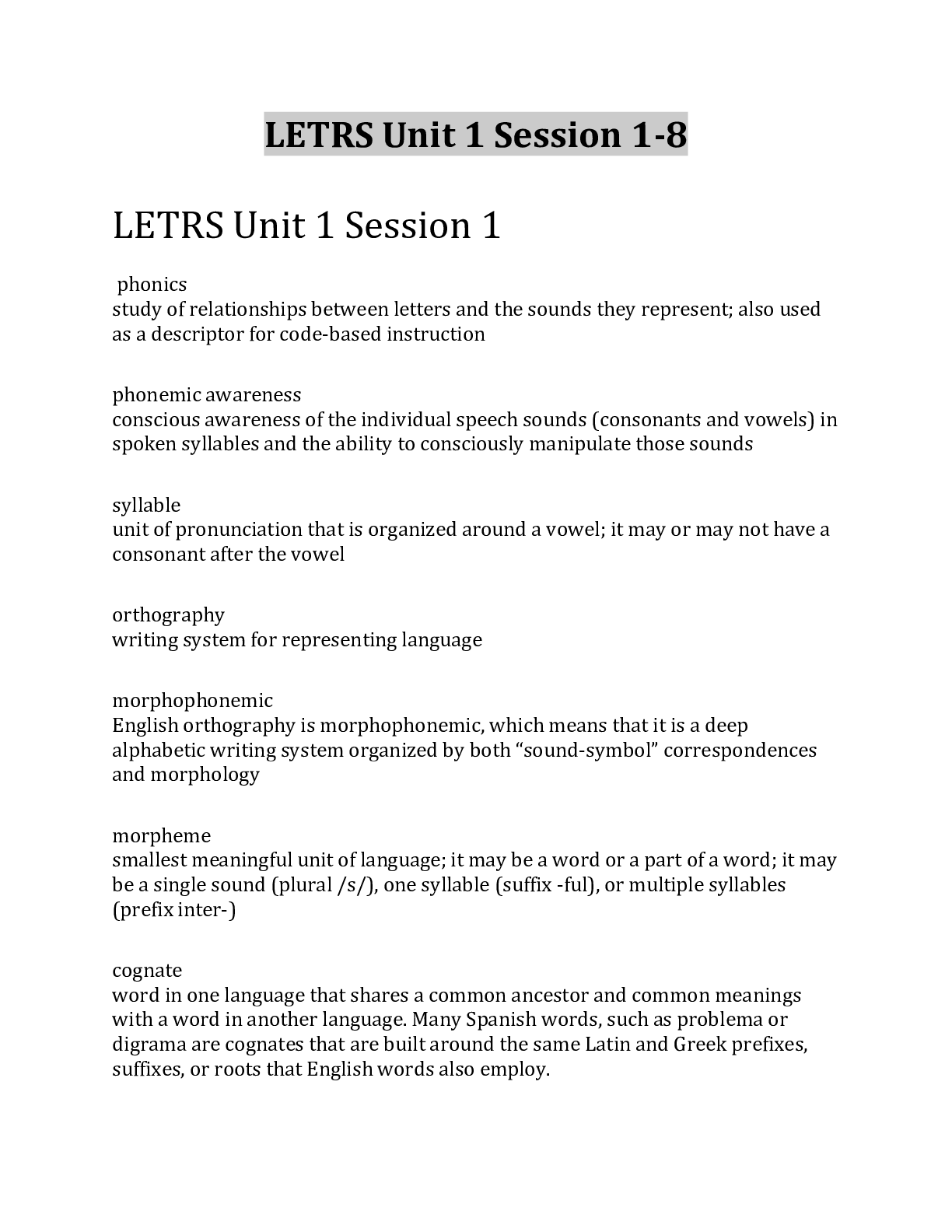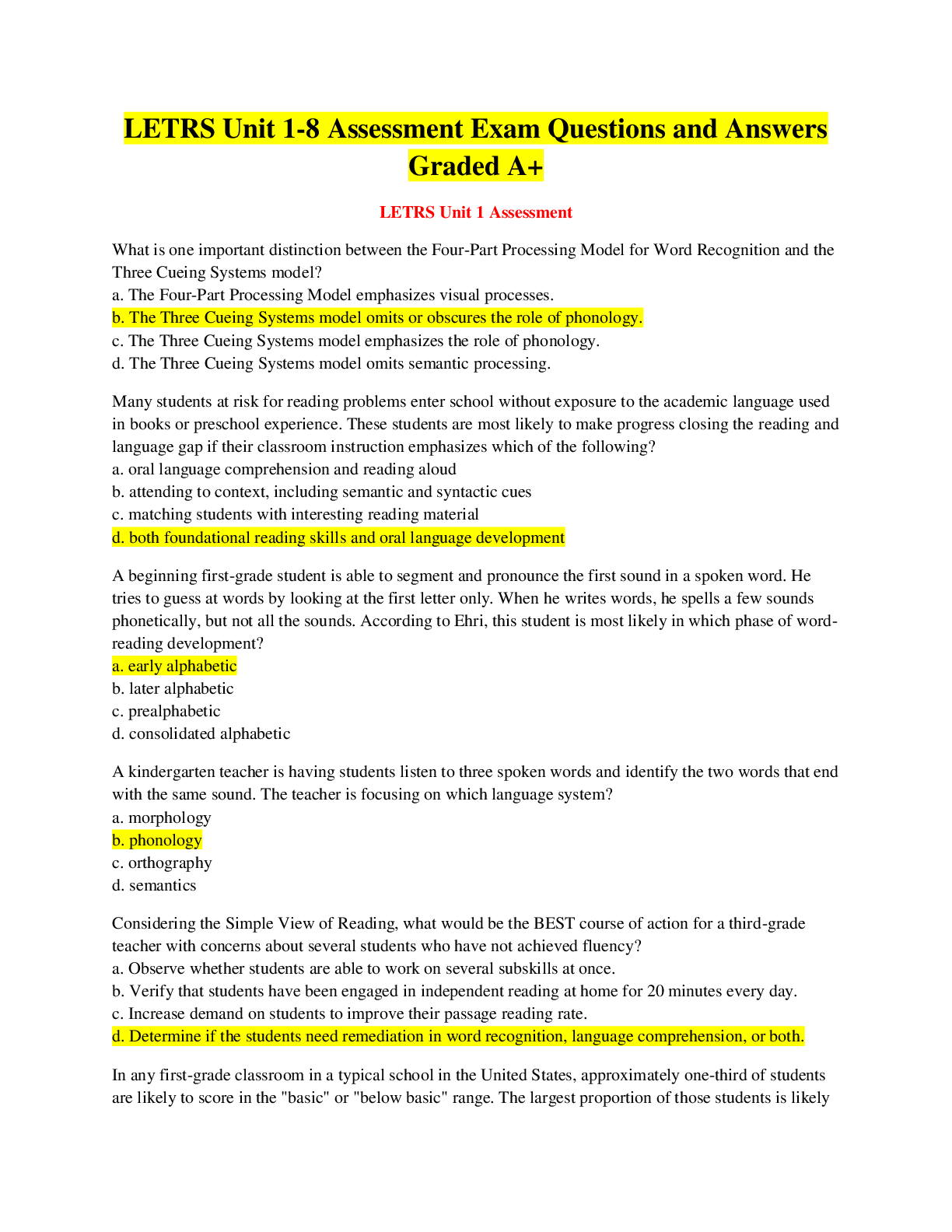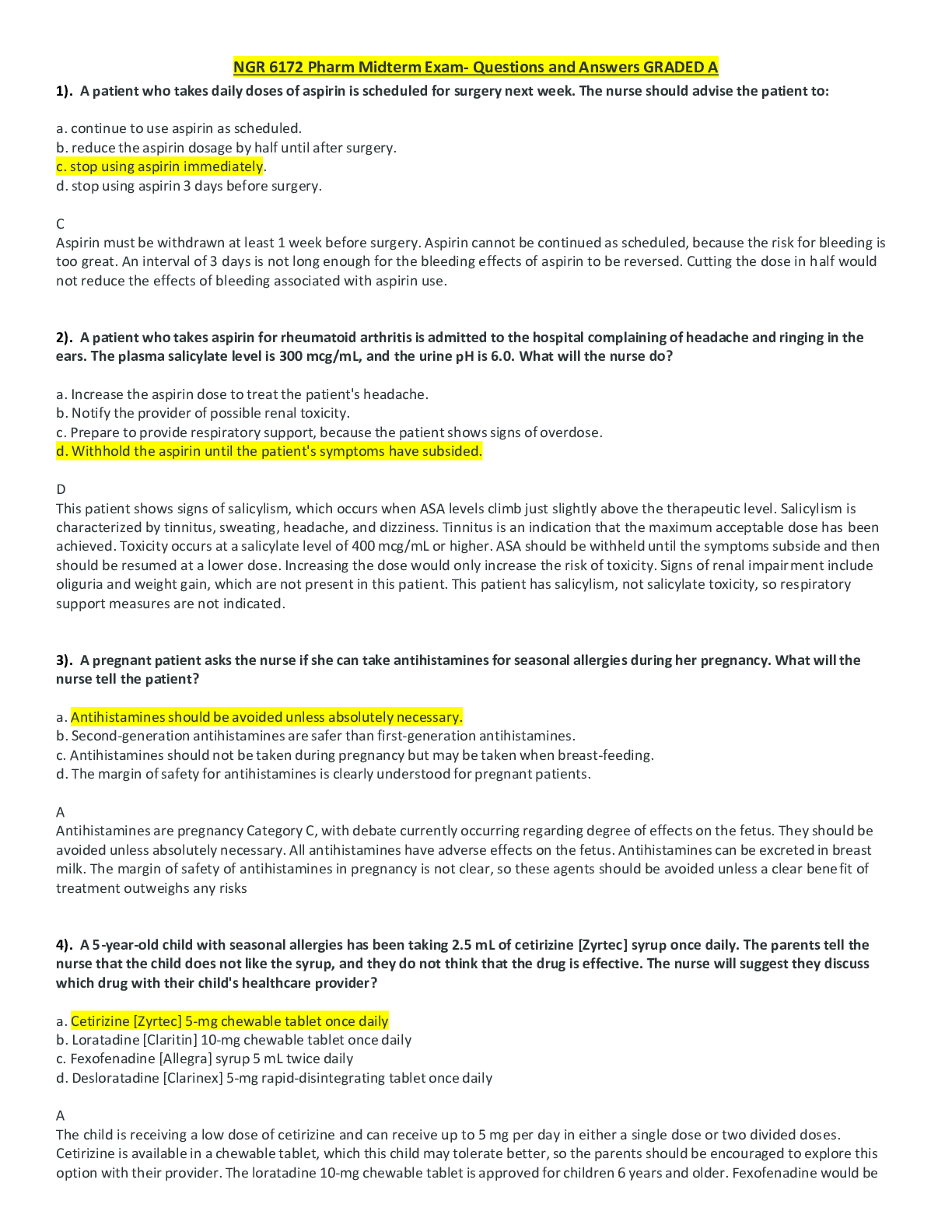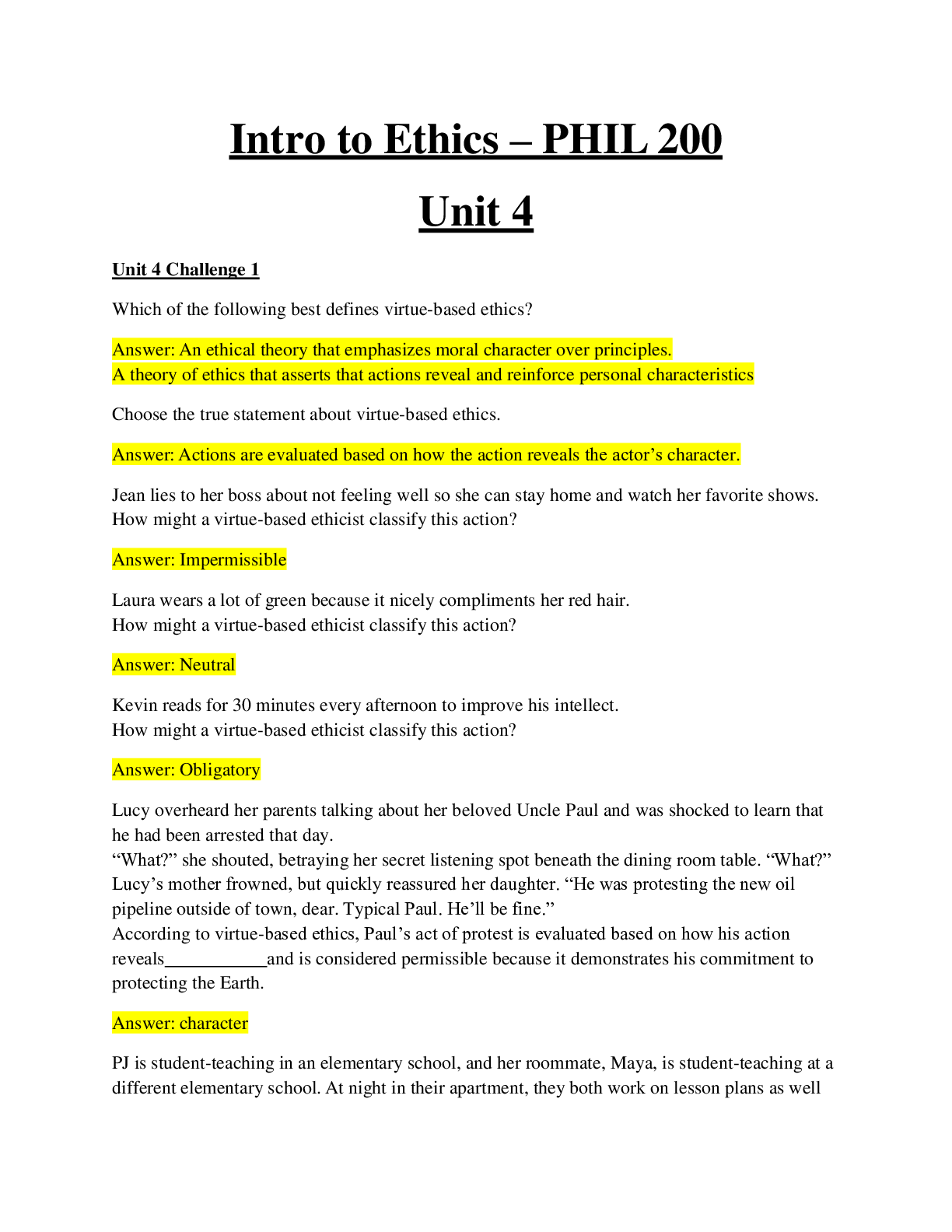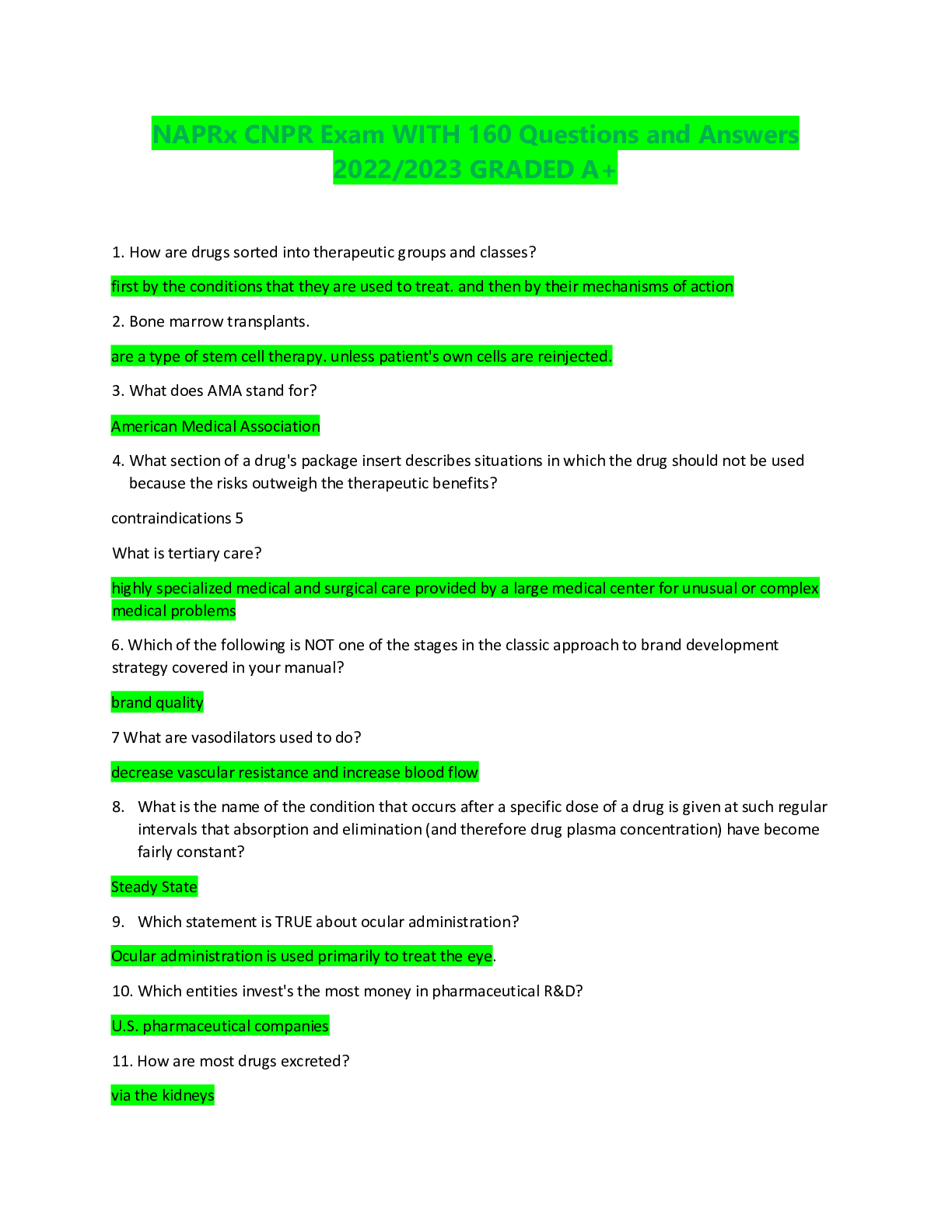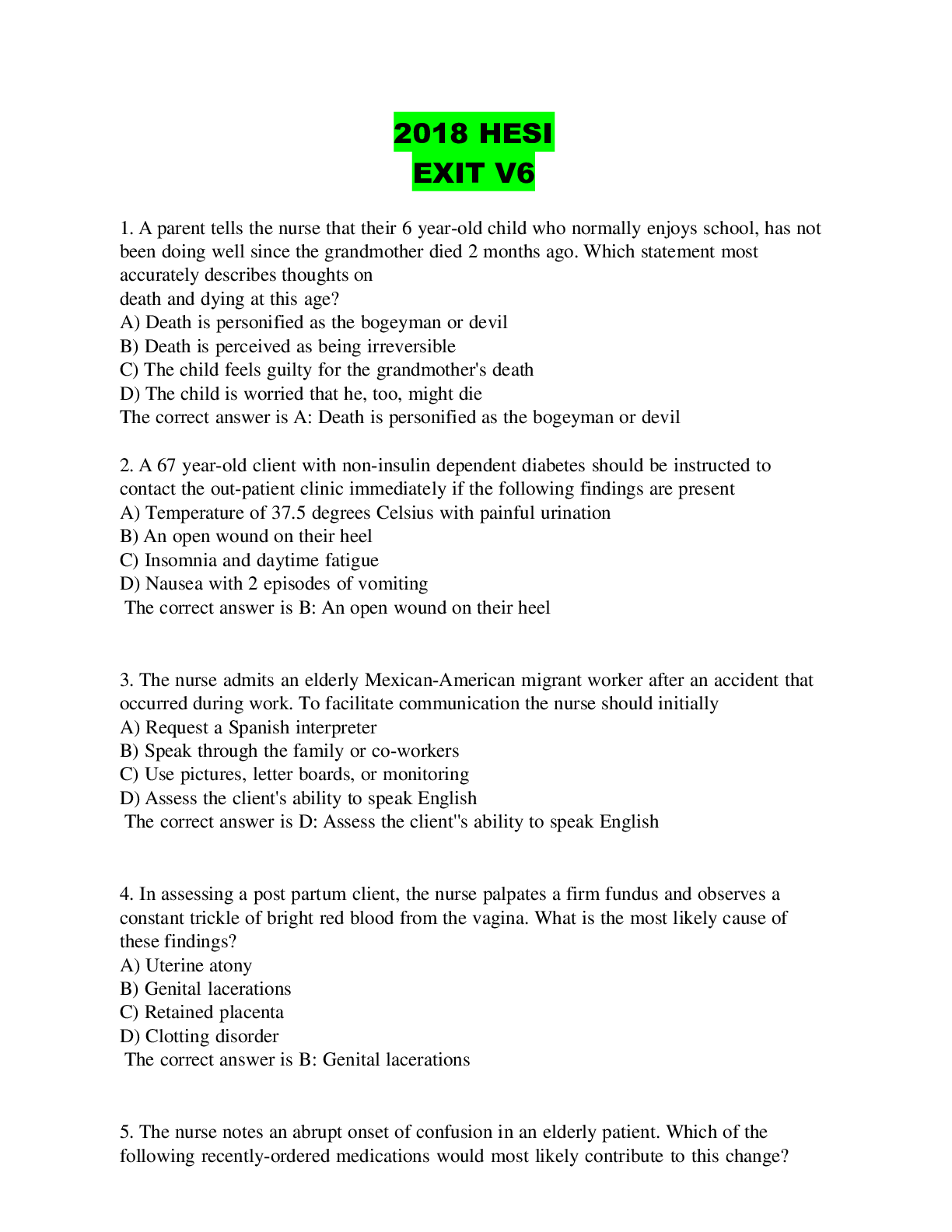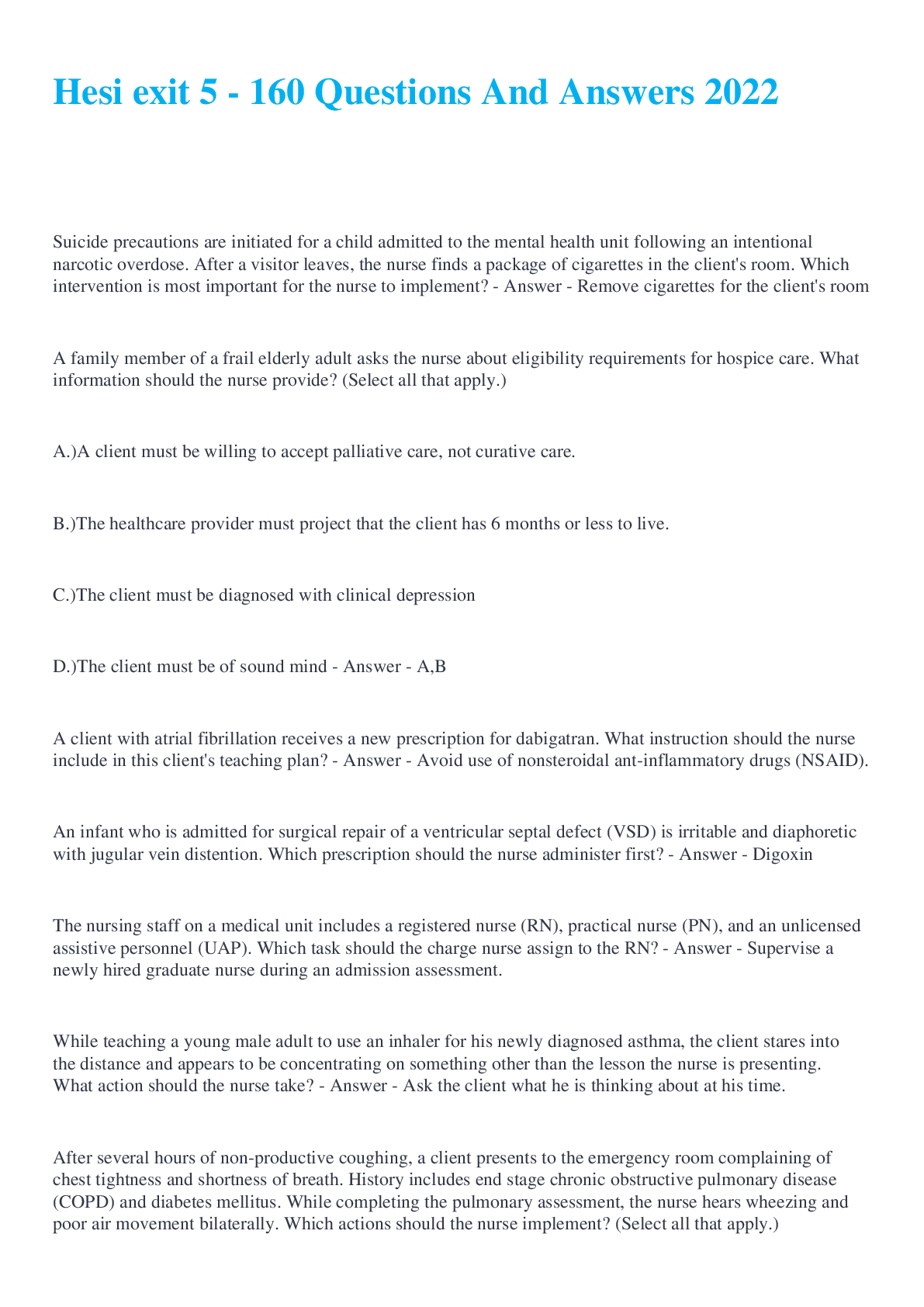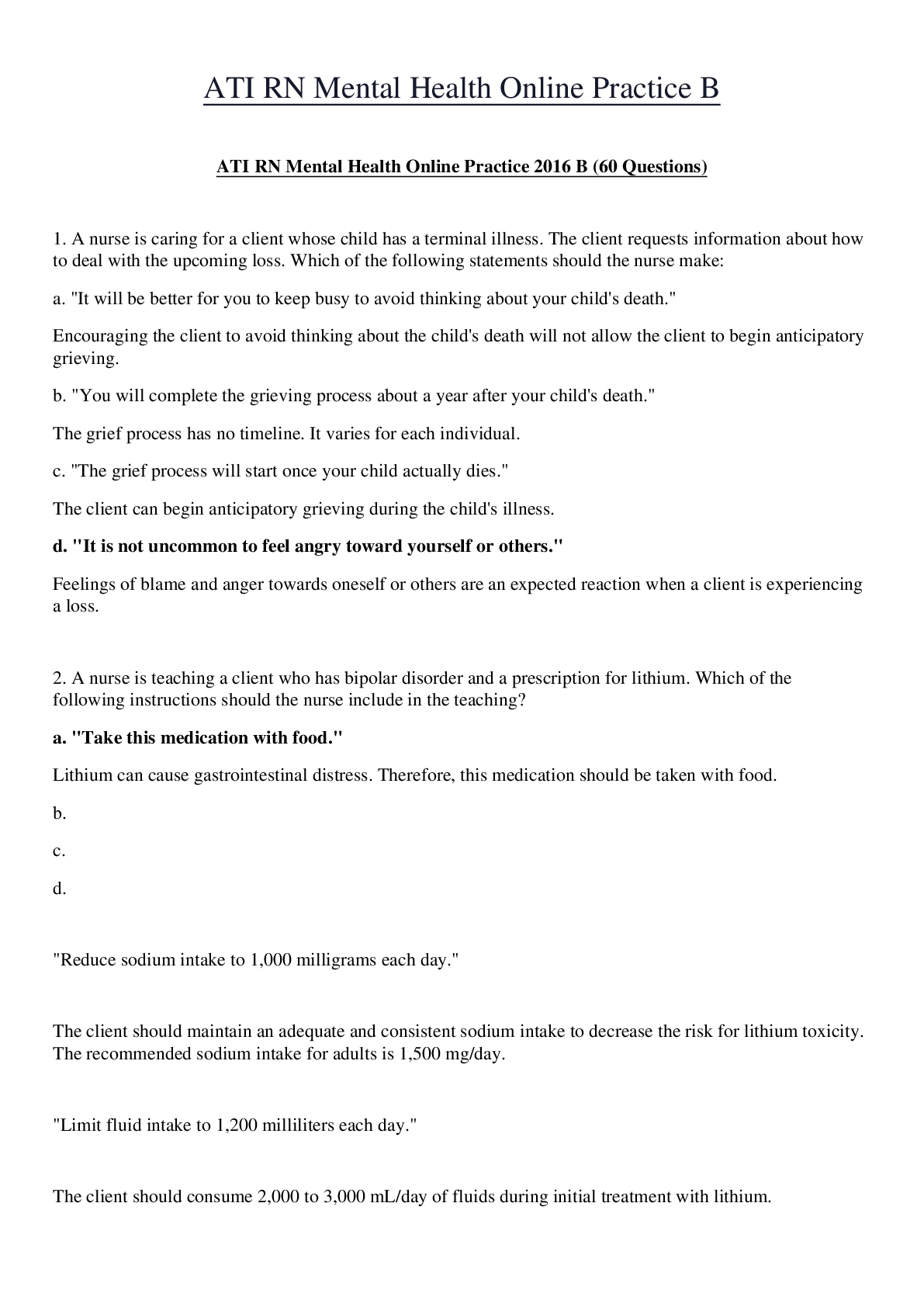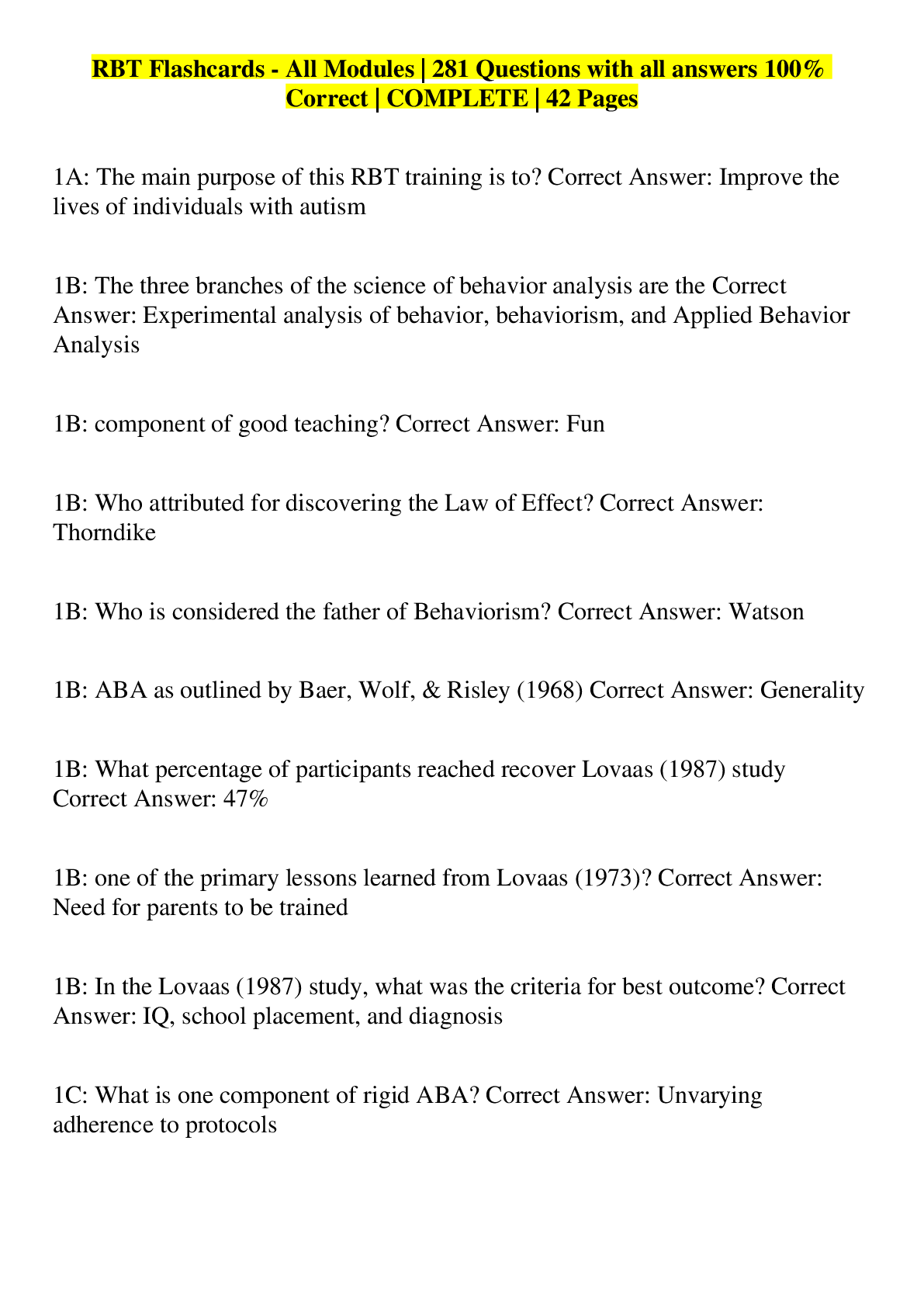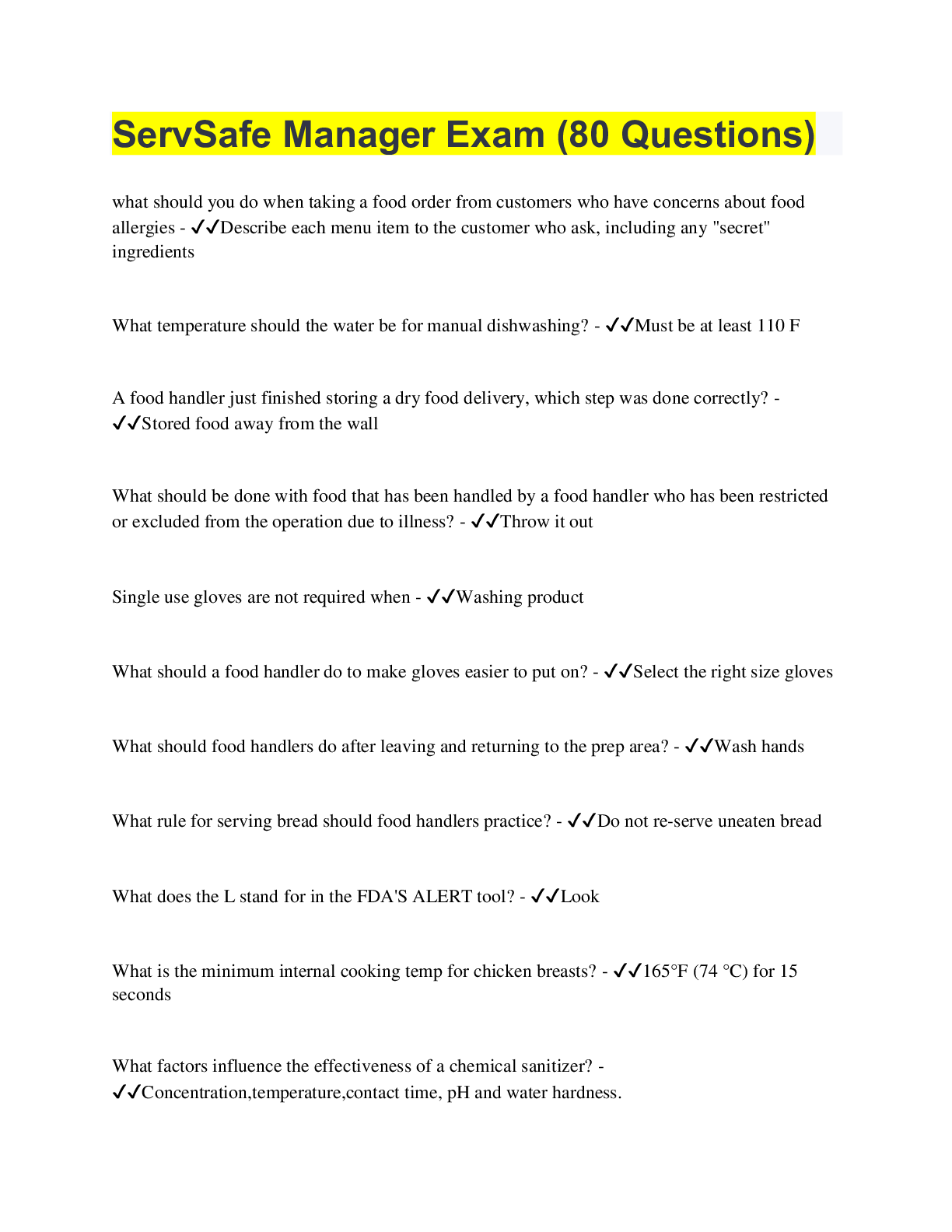*NURSING > EXAM > Rasmussen College: NUR 2790 Nursing III Exam III Questions and Answers Latest updated 2021/2022,100% (All)
Rasmussen College: NUR 2790 Nursing III Exam III Questions and Answers Latest updated 2021/2022,100% CORRECT
Document Content and Description Below
Rasmussen College: NUR 2790 Nursing III Exam III Questions and Answers Latest updated 2021/2022 Nursing III Exam III Chapter 65 The nurse is caring for a client who has sustained multiple injuries... from a motor vehicle accident. The nurse realizes that the client will have a release of stress hormones that are useful for all of the following EXCEPT: Preventing ingestion of food The nurse is planning care for a client diagnosed with acute respiratory distress syndrome (ARDS)? Which of the following is not included in the management of this disorder? Promoting urine output The nurse, caring for a client diagnosed with shock, realizes that the stage in which the body attempts to remedy the problem by initiating the homeostatic mechanism would be? Compensatory stage A client experiences a bee sting, complains of difficulty breathing, and shows sign of hypoxia and hypotension. The nurse realizes these are signs of anaphylactic shock, and she should do which of the following first? Give epinephrine intravenously or via endotracheal tube A client is diagnosed with failure of the left ventricle to provide adequate delivery of oxygen to the body tissues due to a weakened forward pumping function of the heart. The nurse realizes this client is experiencing: cardiogenic shock To assess if the renal system in a client diagnosed with multisystem failure is functioning properly, the nurse would expect to see urine output of: 30 mL per hour The nurse realizes that a client, diagnosed with neurogenic shock, is at risk for developing: deep vein thrombosis A client is diagnosed with septic shock. The nurse realizes that the major cause of this type of shock is: gram-negative bacteria A client is diagnosed with cardiogenic shock. The nurse should plan interventions to address which of the following potential complications of this disorder? Myocardial infarction The nurse is concerned that a client will develop neurogenic shock when which of the following is assessed? Spinal cord injury at T1 The nurse is planning care for a client diagnosed with disseminated intravascular coagulation. Which of the following should be included in this plan of care? Avoid intramuscular injections A firefighter is brought to the emergency department with complaints of headache, weakness, shortness of breath, cough, and chest pain. During the assessment of this client, the nurse realizes the client should be evaluated for: Cyanide poisoning The nurse is assessing a client for the acute phase of the inflammatory immune response. Which of the following are considered cardinal signs of this response? (Select all that apply.) Rubor Tumor Dolor Calor The nurse is determining if a client is experiencing chronic inflammation. Which of the following are indications for this type of inflammation? (Select all that apply.) Chronic elevation of white blood cells Low-grade fever Pain Scar formation The nurse is assessing a client for systemic inflammatory response syndrome (SIRS). Which of the following disease processes are associated with this syndrome? (Select all that apply.) Infection Pancreatitis Ischemia Trauma Massive transfusions A client is experiencing symptoms associated with distributive shock. What types of shock are included in this category? (Select all that apply.) Neurogenic Anaphylactic Septic The nurse is caring for a client experiencing hypovolemic shock. Which of the following interventions would be appropriate for this client? (Select all that apply.) Monitor intravenous fluid replacement Monitor vital signs Assess for manifestations of fluid overload Monitor white blood cell count and hemoglobin and hematocrit levels Position for comfort Chapter 24 A client is learning about cholesterol. The nurse explains that the good cholesterol transports plasma cholesterol away from plaques and to the liver for metabolism. This type of cholesterol is called: high-density lipoprotein A client has a blood pressure of 124/78 mmHg and a triglyceride level of 160 mg/dL. Based on these results, the nurse knows that the client has: a prehypertensive blood pressure and a borderline high triglyceride level The nurse measures a client's blood pressure to be 158/92 mmHg. The nurse recognizes that this blood pressure is classified as: stage I hypertension A client is complaining of chest pain that occurs during exercise. This pain is relieved when the client rests. The nurse realizes that this client is experiencing which type of angina? Stable angina A client diagnosed with stable angina is undergoing a 12-lead electrocardiogram. Which of the following results is not expected? ST segment elevation A client is scheduled for a cardiac angiogram. Which of the following should the nurse instruct the client about this diagnostic test? Contrast dye is injected When planning the care of a client diagnosed with stable angina, which of the following would be considered a goal of treatment? Decrease in ischemia and episodes of angina A client is prescribed a beta-blocker for treatment of coronary artery disease. Which of the following is the client most likely going to be prescribed? Atenolol A client tells the nurse that using nitroglycerin tablets causes a tingling sensation and a headache. The nurse knows that this is: Expected A nurse is considering contraindications to fibrinolytic therapy. Which of the following patients is an appropriate candidate for fibrinolytic therapy? A patient with a history of a motor vehicle accident 1 year ago A client is participating in cardiac rehabilitation and is currently engaging in supervised exercise, counseling, and education. The nurse realizes this client is in which phase of cardiac rehabilitation? Phase III A client tells the nurse that he ingests an NSAID when the angina pain gets really bad, and it eliminates the pain. The nurse suspects the client is experiencing: Musculoskeletal pain A client is prescribed nicotinic acid as part of treatment for coronary artery disease. Which of the following should the nurse instruct the client regarding this medication? Ingest an aspirin 30 minutes before taking the medication and after eating The nurse is assessing the pain of a client experiencing angina. Which of the following should be included in this assessment? (Select all that apply.) Precipitating event Quality Radiation Severity Timing A client is at risk for coronary artery disease. Which of the following should the nurse instruct as modifiable risk factors for this health condition? (Select all that apply.) Alcohol consumption Diabetes mellitus Low daily fruit intake Psychosocial index A client is diagnosed with angina after describing the type of pain she experiences. Which of the following are characteristics of anginal pain? (Select all that apply.) Pressure Heavy Squeezing Demonstrates a clenched fist over the sternum A client is experiencing a sudden onset of chest pain. Which of the following will the nurse do to manage this chest pain? Administer intravenous morphine as prescribed Provide oxygen Administer nitroglycerin as prescribed Administer aspirin as prescribed Which of the following will the nurse instruct a client being discharged to home after experiencing an acute myocardial infarction? (Select all that apply.) Understand cardiac condition How to manage chest pain Activity level Medications Risk factors Chapter 54 The nurse, caring for a client diagnosed with pyelonephritis, realizes that common risk factors for the development of this disorder include all of the following EXCEPT: orthostatic hypotension A client is diagnosed with autosomal dominant polycystic kidney disease. During data collection, which assessment finding would the nurse expect to discover? Pain and hematuria A client is being prescribed medication to treat polycystic kidney disease. Which of the following medications would be indicated for this client? Cephalosporin A client is diagnosed with resistant polycystic kidney disease. The medications which may be indicated for this client would be: clindamycin and gentamicin A client is diagnosed with rhabdomyolysis. The nurse realizes that an emergency condition that may occur with this diagnosis would be: compartment syndrome During the admitting assessment process, a client asks, What is oliguria? Based on the nurses knowledge, the best response would be: Oliguria is a urine output less than 400 mL in 24 hours A client is diagnosed with acute renal failure. Which of the following diagnostic studies will the nurse be most concerned with? Potassium and digitalis levels A client has been prescribed a restricted potassium diet. An appropriate snack for the client would be: Applesauce A client diagnosed with chronic renal failure is prescribed a diet low in protein. The rationale for this diet is that: protein sources are broken down and converted to urea, which is then filtered by the kidney A client diagnosed with chronic renal failure asks the nurse, Whats the difference between hemodialysis and peritoneal dialysis? Which of the following statements best explains the difference? Hemodialysis uses a graft or fistula and pumps blood through a semipermeable membrane in a hemodialyzer as the filter. Peritoneal dialysis uses the peritoneal lining of the abdominal cavity as the filter. The nurse would expect that a client recovering from a kidney transplant would be prescribed all the following medications EXCEPT: Vancomycin A client diagnosed with acute renal failure from an intrarenal cause should be instructed to: avoid using NSAIDs A client diagnosed with acute renal failure has a magnesium level of 1.0 mg/dL Which of the following will the nurse most likely assess in this client? No clinical signs After the nurse provides a client diagnosed with acute renal failure with Kayexalate 30 grams by mouth, the client begins to experience frequent loose bowel movements. Which of the following does this clients response indicate to the nurse? The client is experiencing a response that is indicative of successful treatment The nurse is assessing circulation through a clients arteriovenous shunt. Which of the following are signs of a patent site? (Select all that apply.) Positive bruit Palpable thrill For a client to be diagnosed with Anti-Glomerular Basement Membrane disease, the nurse realizes that which of the following characteristics must be present? (Select all that apply.) Antiglomerular basement membrane (GBM) antibodies Pulmonary hemorrhage Proliferative glomerulonephritis During discharge teaching with a client diagnosed with autosomal dominant polycystic kidney disease, the nurse should stress which of the following points? (Select all that apply.) Void frequently Practice good perineal hygiene Void after intercourse Take showers The nurse is caring for a client diagnosed with pyelonephritis. Which of the following are appropriate interventions that the nurse should perform? (Select all that apply.) Ensure adequate hydration Monitor vital signs and fluid balance Provide urinary antiseptics Monitor electrolytes and creatinine level The nurse is caring for a client diagnosed with chronic renal failure. Which of the following would be considered expected manifestations of this disorder? (Select all that apply.) Left ventricular dysfunction Anemia Constipation Prickly burning sensation of the extremities Restless legs A client is diagnosed with Wegeners granulomatosis. Which of the following will the nurse most likely assess in this client? (Select all that apply.) Shortness of breath and cough Tinnitus Conjunctivitis Muscle aches Chapter 56 A male client is diagnosed with hyperprolactinemia. The nurse realizes that which of the following clinical manifestations occurs less frequently in men? Gynecomastia A female client is admitted with hyperprolactinemia. Which of the following would not be a clinical manifestation of the disorder in this client? Excessive estrogen A client has been instructed regarding a prolactin level to be drawn the next day. Which of the following statements indicate that the client will need further instruction? I will be on time, in the afternoon An adult client is complaining of vision changes and difficulty speaking because the tongue is larger. The client also states that his shoes no longer fit. Based on these symptoms, the client is most likely to be diagnosed with: Acromegaly A client is prescribed medication after recovering from surgery to treat acromegaly. Which of the following medications would the nurse expect to see prescribed? Octreotide (Sandostatin) 20 mg IM every 4 weeks A client, complaining of weight gain, has thin extremities, a buffalo hump, and a protruding abdomen. The nurse realizes that this client is most likely to be diagnosed with which disease process? Cushings syndrome The nurse is providing instructions to a client receiving treatment for Cushings syndrome. Which of the following instructions would not be appropriate for this client? Volunteer at the hospital to prevent depression The nurse is assessing a client diagnosed with hyperaldosteronism. Which of the following would take the least priority during this period? Assistance with activities of daily living (ADLs) A client is diagnosed with primary adrenal insufficiency. The nurse realizes that this disorder affects which of the following glands? Adrenal cortex A client tells the nurse that he is so thirsty that he has already consumed four pitchers of water. The clients urine output is 3500 mL in an 8-hour period. The client is recovering from surgery on the pituitary gland. What endocrine disorder is the client most likely experiencing? Diabetes insipidus The nurse is planning care for a client diagnosed with Graves disease. Which of the following nursing interventions would be appropriate for this clients care? Provide frequent meals A client is hospitalized with an ongoing fever. The nurse learns that the client has had a recent infection. Currently the client is restless, diaphoretic, and agitated with the following vital signs: temperature 106F, pulse 114, blood pressure 180/80 mmHg. Which of the following disorders is the client most likely experiencing? Thyroid crisis A pregnant client is receiving treatment for hyperthyroidism. Which of the following medications would the nurse expect to see? Propylthiouracil A client is diagnosed with chronic lymphocytic thyroiditis. The nurse should instruct the client regarding signs and symptoms of which of the following? Hypothyroidism Which of the following symptoms would suggest to the nurse that a client is experiencing symptoms of pheochromocytoma? (Select all that apply.) Severe headache Palpitations Profuse sweating A client is receiving diagnostic tests to determine the presence of a malignant thyroid lesion. Which of the following are symptoms that are usually associated with a malignant thyroid? (Select all that apply.) Hoarseness Onset of dysphagia Age 20; male gender Thyroid scan revealing a cold nodule Presence of a single firm nodule The nurse suspects a client is experiencing the early signs of myxedema coma when which of the following is assessed? (Select all that apply.) Reduced level of consciousness Hypothermia Hypoventilation Hypotension Bradycardia The nurse is planning care for a client diagnosed with hypercalcemia caused by hyperparathyroidism. Which of the following should the nurse add as interventions to this clients care plan? (Select all that apply.) Administer high volume intravenous fluids as prescribed Calculate sodium chloride intake to achieve 400 mEq each day [Show More]
Last updated: 1 year ago
Preview 1 out of 17 pages
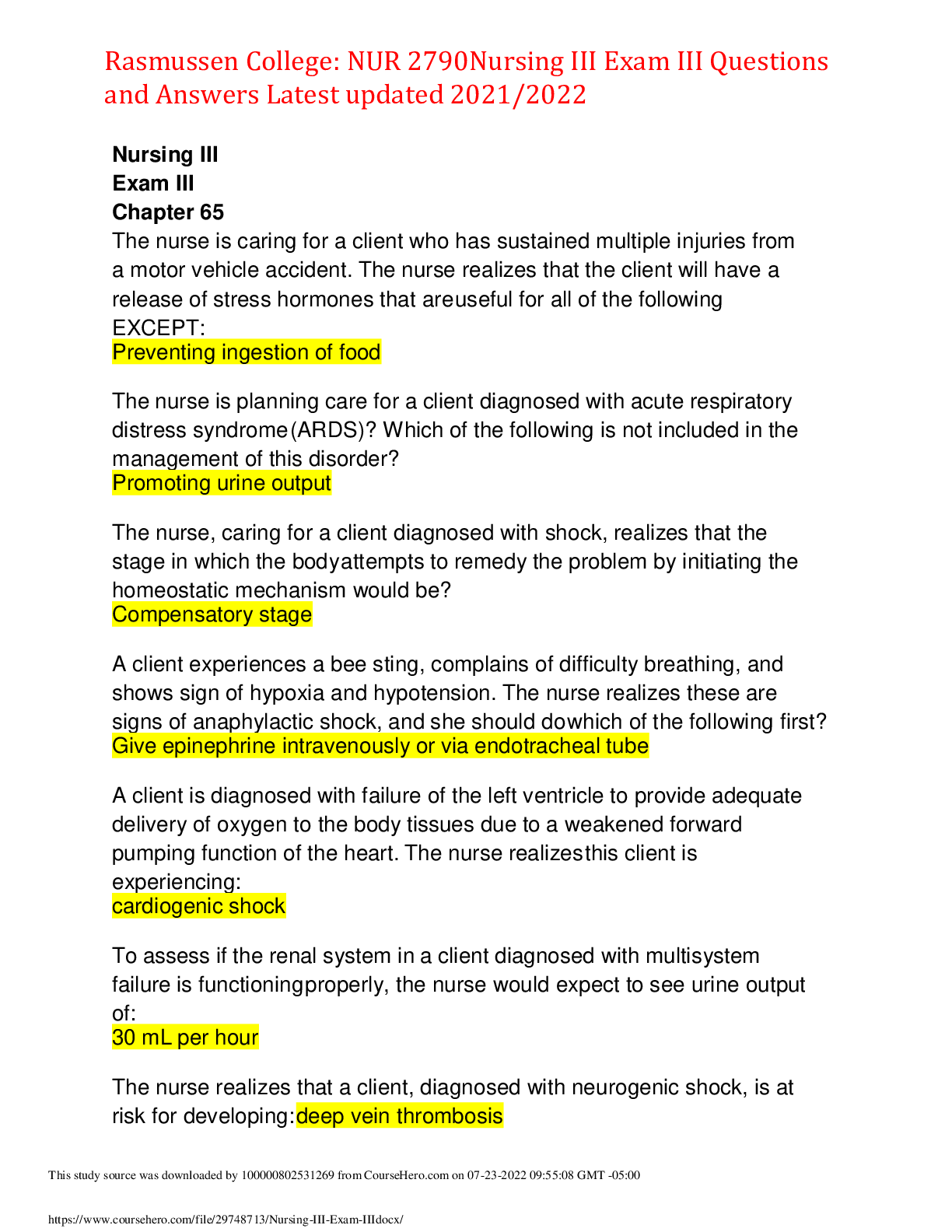
Reviews( 0 )
Document information
Connected school, study & course
About the document
Uploaded On
Jul 23, 2022
Number of pages
17
Written in
Additional information
This document has been written for:
Uploaded
Jul 23, 2022
Downloads
0
Views
69




